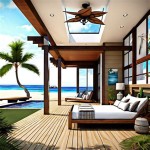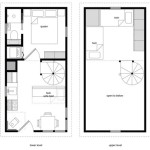Family House Plans are detailed blueprints that outline the design and layout of a home specifically intended for the needs of families. These plans typically include multiple bedrooms, bathrooms, and communal living spaces, ensuring ample room for family members to live and interact comfortably.
Families considering building a new home or renovating an existing one can benefit greatly from utilizing Family House Plans. They provide a comprehensive guide that outlines the home’s structure, electrical systems, plumbing, and more, minimizing the risk of costly errors during the construction process. By incorporating these plans, families can create a customized living space tailored to their unique needs and lifestyle.
In the following sections of this article, we will delve deeper into the key elements of Family House Plans, exploring their various components and discussing the advantages they offer to families.
Family House Plans are meticulously crafted to meet the specific requirements of families, ensuring a comfortable and functional living environment. Here are eight key points to consider when exploring these plans:
- Multiple bedrooms
- Adequate bathrooms
- Spacious living areas
- Efficient kitchen design
- Designated storage spaces
- Outdoor living areas
- Energy efficiency
- Smart home features
These elements work together to create a home that caters to the needs of families, fostering a sense of comfort, togetherness, and well-being.
Multiple bedrooms
Family House Plans typically incorporate multiple bedrooms to accommodate the varying needs of family members. These bedrooms serve as private sanctuaries for sleep, study, and relaxation.
- Master bedroom: The master bedroom is typically the largest and most luxurious bedroom in the house, reserved for the parents or guardians. It often includes a private bathroom, walk-in closet, and additional amenities such as a sitting area or balcony.
- Children’s bedrooms: Children’s bedrooms are designed to provide a comfortable and stimulating environment for younger family members. They may include built-in storage, desks, and play areas to cater to their specific needs and interests.
- Guest bedroom: A guest bedroom provides a dedicated space for overnight guests, offering privacy and comfort. It may be smaller than the other bedrooms but should still include essential amenities such as a bed, dresser, and closet.
- Flex room: Some Family House Plans include a flex room that can be adapted to serve various purposes. It can be used as an additional bedroom, a playroom, a home office, or a hobby room, offering flexibility to meet changing family needs.
The number and size of bedrooms in a Family House Plan will vary depending on the size and composition of the family. However, providing multiple bedrooms ensures that each family member has a private space to retreat to, fostering a sense of independence and well-being.
Adequate bathrooms
Adequate bathrooms are essential in any family home, ensuring privacy, convenience, and hygiene for all family members.
- Multiple bathrooms: Family House Plans typically include multiple bathrooms to accommodate the needs of all family members, especially during peak times like mornings and evenings. This eliminates the need for excessive waiting and ensures that everyone can get ready for their day or prepare for bed without inconvenience.
- Full bathrooms: Full bathrooms include a toilet, sink, and bathtub or shower, providing a complete and private bathing experience. They are typically located near bedrooms for easy access, especially for children and elderly family members.
- Half bathrooms: Half bathrooms, also known as powder rooms, include a toilet and sink but no bathtub or shower. They are often located on the main floor of the house for convenience and to accommodate guests without giving them access to more private areas of the home.
- Jack-and-Jill bathrooms: Jack-and-Jill bathrooms are shared by two bedrooms, typically children’s bedrooms. They offer a private bathroom without the need for each bedroom to have its own separate bathroom, maximizing space efficiency.
The number and type of bathrooms in a Family House Plan will depend on the size and composition of the family. However, ensuring adequate bathrooms is crucial for maintaining a comfortable and harmonious living environment.
Spacious living areas
Spacious living areas are a hallmark of Family House Plans, providing ample room for family members to gather, interact, and create lasting memories.
Open floor plans: Open floor plans seamlessly connect the living room, dining room, and kitchen, creating a spacious and inviting communal area. This design encourages family interaction and fosters a sense of togetherness. Open floor plans are particularly beneficial for families with young children, as parents can easily keep an eye on them while preparing meals or engaging in other activities.
Large windows and natural light: Family House Plans often incorporate large windows and skylights to maximize natural light and create a bright and airy atmosphere. Natural light has been shown to improve mood, boost energy levels, and reduce stress, contributing to a healthy and happy family environment.
Multi-purpose rooms: Multi-purpose rooms offer flexibility and adaptability to meet the changing needs of families. These rooms can serve as a playroom for children, a home office for parents, or a media room for family entertainment. They provide additional space for activities and hobbies, reducing the need for separate dedicated rooms.
Spacious living areas in Family House Plans not only provide physical space but also foster a sense of connection, well-being, and shared experiences for families.
Efficient kitchen design
Efficient kitchen design is paramount in Family House Plans, ensuring that the kitchen is not only a functional workspace but also a gathering place for family and friends.
Work triangle: The work triangle is a fundamental concept in kitchen design, connecting the three main work zones: the sink, refrigerator, and cooktop. By placing these elements in close proximity and forming a triangle, the kitchen becomes more efficient and ergonomic, reducing unnecessary movement and maximizing productivity.
Ample storage: Family House Plans incorporate ample storage solutions to keep the kitchen organized and clutter-free. This includes a combination of cabinets, drawers, pantries, and shelves, ensuring that there is a dedicated space for every item, from food and cookware to cleaning supplies.
Island or peninsula: Kitchen islands and peninsulas provide additional counter space and storage, making meal preparation and serving more convenient. They also serve as a casual eating area for quick meals or snacks, and can even incorporate a sink or cooktop for added functionality.
Efficient kitchen design in Family House Plans not only enhances the functionality of the space but also creates a welcoming and efficient environment for families to cook, eat, and connect.
Designated storage spaces
Designated storage spaces are meticulously planned into Family House Plans to maintain organization and reduce clutter, ensuring a tidy and functional living environment.
Closets and wardrobes: Ample closet and wardrobe space is incorporated into bedrooms and other areas of the house to accommodate clothing, shoes, and accessories. Walk-in closets provide generous storage capacity and allow for easy organization, while built-in wardrobes maximize space utilization.
Cabinets and drawers: Cabinets and drawers are strategically placed throughout the house, providing concealed storage for a variety of items. Kitchen cabinets store cookware, dishes, and food supplies, while bathroom cabinets house toiletries and linens. Drawers in bedrooms and hallways offer organized storage for personal belongings, keeping spaces neat and clutter-free.
Pantry and utility room: A pantry is a dedicated space for storing non-perishable food items, keeping the kitchen organized and functional. Utility rooms provide additional storage for household appliances, cleaning supplies, and other miscellaneous items.
Designated storage spaces in Family House Plans not only maintain order and cleanliness but also contribute to a more efficient and enjoyable living environment for families.
Outdoor living areas
Outdoor living areas are carefully integrated into Family House Plans, extending the living space beyond the walls of the house and creating a seamless connection between the indoors and outdoors.
Patios and decks: Patios and decks provide a transition zone between the house and the yard, offering a comfortable and inviting space for outdoor dining, relaxation, and entertainment. They can be constructed from a variety of materials, such as wood, concrete, or composite decking, and can be customized in size and shape to suit the specific needs of the family.
Screened porches and sunrooms: Screened porches and sunrooms offer protection from insects and inclement weather, while still allowing families to enjoy the outdoors. Screened porches are typically enclosed with screens on all sides, while sunrooms may have glass windows and a roof, providing a more sheltered and comfortable outdoor living space.
Landscaping and gardens: Landscaping and gardens play a vital role in creating a cohesive outdoor living area. Thoughtful placement of trees, shrubs, and flowers can provide privacy, shade, and aesthetic appeal. Gardens can provide fresh produce, herbs, and flowers, while also serving as a fun and educational activity for families.
Energy efficiency
Energy efficiency is a crucial consideration in Family House Plans, as it not only reduces environmental impact but also lowers energy bills and enhances the overall comfort and health of the home.
Insulation and air sealing: Proper insulation in walls, ceilings, and floors minimizes heat loss and gain, reducing the need for heating and cooling. Air sealing measures, such as caulking and weatherstripping, prevent drafts and air leaks, further improving energy efficiency.
Energy-efficient appliances and lighting: Family House Plans prioritize the use of energy-efficient appliances, such as refrigerators, dishwashers, and washing machines, which consume less energy without compromising performance. Energy-efficient lighting, including LED and CFL bulbs, provides bright illumination while reducing energy consumption.
Renewable energy sources: Some Family House Plans incorporate renewable energy sources, such as solar panels and geothermal heating and cooling systems. These systems harness natural resources to generate electricity or regulate temperature, reducing reliance on fossil fuels and promoting environmental sustainability.
Smart home features: Smart home features, such as programmable thermostats and motion-activated lighting, can further enhance energy efficiency. These systems allow families to automate energy usage, optimizing heating and cooling schedules and reducing energy waste.
Smart home features
Smart home features are increasingly integrated into Family House Plans, offering families convenience, security, and energy efficiency. These features allow homeowners to automate various aspects of their home’s operation, creating a more comfortable and streamlined living environment.
Smart lighting: Smart lighting systems use sensors and connectivity to automate lighting throughout the house. They can be programmed to turn on and off at specific times, adjust brightness levels based on natural light, and even change color to create different ambiences. Smart lighting not only enhances convenience but also contributes to energy savings by reducing unnecessary lighting usage.
Smart thermostats: Smart thermostats learn family routines and preferences to optimize heating and cooling schedules. They can be controlled remotely via smartphone or voice assistants, allowing families to adjust the temperature from anywhere. Smart thermostats also integrate with other smart home devices, such as motion sensors and smart lighting, to further enhance energy efficiency.
Smart security systems: Smart security systems provide peace of mind and protection for families. They include features such as motion sensors, door and window sensors, and security cameras that can be monitored remotely. Smart security systems can send alerts to homeowners’ smartphones or trigger alarms in case of an intrusion, providing an added layer of security.










Related Posts








